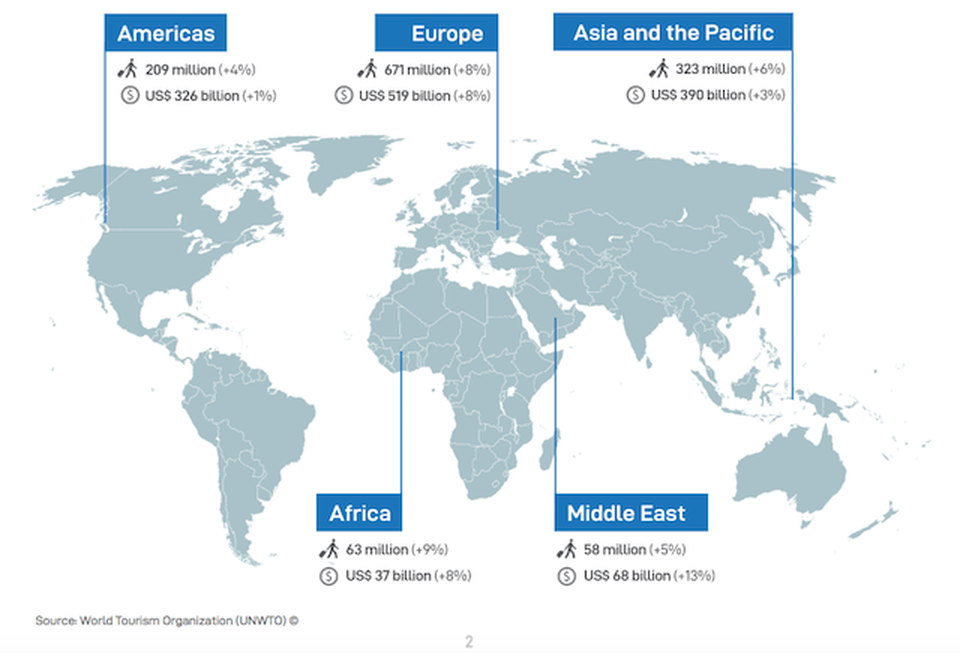The history of travel dates back as far as we do, whether we’re thinking about our ancestors migrating across continents, explorers discovering lands and seas unknown to them, or the growth of civilizations and empires. The urge to travel can maybe best be ascribed to curiosity about the unknown.
“If there is one thing which has defined human nature throughout history it is our fidgety, irrepressible impulse to move, to discover and cross new frontiers, to adapt to new environments, to appease that same unquenchable curiosity which prompted our earliest ancestors to swing down from the treetops and start exploring the jungle floor six million years ago.” – Will Jones
The travel and tourism industry is now one of the largest in the world. International tourist arrivals have grown steadily from 528 million in 2005 to 1.19 billion in 2015, with projections that we’re on our way to 1.8 billion by 2030. In parallel, global international tourism revenue has almost doubled since 2005, reaching approximately 1.26 trillion U.S dollars in 2015. One in nine jobs depended on the travel and tourism industry in 2017 (Statista).
However, this increase in travel and tourism brings with it costs, both environmental and social, to destination communities. The documentary, Gringo Trails, unfolds the deleterious global impact of travel that has been occurring for the last thirty years, ranging from infrastructure overload, environmental devastation and economic weakness of the destination communities. And these effects continue to worsen by the second.
Over 5 billion people globally live without any form of sewage system, and 3 and a half million dying from dirty water and related diseases, making these communities particularly vulnerable to diseases and overwhelming effects from mass tourism. An estimated 2 billion tons of plastic waste is dumped into the ocean every year, damaging the ever-popular beach vacation destinations. The collective global cost of not acting on climate change is 14 trillion (US$) and rapidly increasing, and though these facts are global and not specific to the travel and tourism industry, they are of constant threat to the longevity of the industry.
Gringo Trails: Effects of Overtourism in Thailand
These costs are driven by the global travel industry’s focus primarily on profit maximization. This focus on the bottom line is not exclusive to the travel industry, of course. It’s the consistent thread we see across the goods and services sector that has led to the uproar of the sustainability movement. We as consumers have a long history of not examining the actions, and therefore the consequences, of the businesses we support through our purchasing power, a tumbleweed effect that has resulted in extraordinary costs to both social and environmental well-being.
Tourism was born out of that innate instinct to discover and move, but as the industry explodes, this instinct becomes destructive by the masses. Unless properly educated, these individual travelers will continue to seek immediate pleasure through travel when there is a dire need to transform perspectives to being globally thoughtful.
Megan Epler Wood, in her forward-looking book Sustainable Tourism on a Finite Planet (2017), elaborates on the effect that expanded travel has had on the degeneration of the planet and our global society, and proposes solutions that could mitigate the destructive nature of the industry.
At its core, the book discusses how imperative it is for decision makers to evaluate the dynamics of our global natural, social and cultural capital. She argues that the insights from this analysis should prompt the industry to make investments in tourism destinations to properly protect vital resources. More specifically, Epler Wood suggests that the industry needs to align with the movements of international organizations, and particularly the United Nations Environmental Programme, in order to transform itself.
She argues that the UN’s Sustainable Development Goals provide a thorough framework for necessary change initiatives, and that partnering that framework with a universal, integrated sustainable tourism accounting system would serve as two vital components for revolutionizing the travel industry. In an ideal world, these solutions would be continuously supported by nations committed to sustainability and financed by a variety of entities, such as the Green Climate Fund.
While there is a rise in socially conscious travelers committing to supporting only sustainable and regenerative travel companies, without the kind of radical transformation suggested by Epler Wood, the industry itself will continue to lag. Small, niche sustainable tourism markets–ecotourism, responsible travel, voluntourism, geotourism, experiential travel–aren’t enough, individually, to make the difference.
Siloed, the individual organizations that fall under these categories are making incredible strides towards sustainable offerings, from providing thorough volunteer opportunities to offsetting air travel to providing finance to the destination communities. This sector is the fastest growing in the industry, at 10-15% annually. The number of eco-tourist arrivals this year has reached 68.5 million and continues to rise. But even aggregated, the same issue persists: there is no cohesive way to account for the impacts, either good or bad.
Though this groundswell is moving in the right direction, the entire industry is still long overdue for a sustainability makeover to ensure its long-term survival.


One thought on “On the Possibility of a Sustainable and Regenerative Travel/Tourism Industry”
Way to go Sara!!!